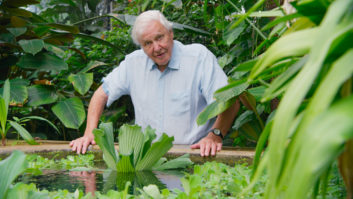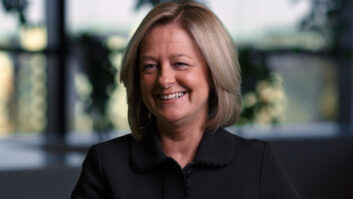According to 2024’s State of MediaTech Report from the IABM, more people in the US are streaming their content than watching it on television. Lots more, in fact, and it’s been going that way for a while with research from EMarketer suggesting that the number of people streaming live sports eclipsed the number watching on traditional broadcast television back in 2023.

That gulf is only going to get bigger. The problem is, scaling the network to support these viewing peaks is both inefficient and expensive, especially when it comes to live events. Event-based broadcasting is where the big spikes in traffic are generated, and as more viewers migrate to IP-based consumption and more sporting events are picked up by companies like Amazon and Netflix who only operate over IP, those peaks are going to get bigger and more frequent and create more problems for viewers.
Multicast-Assisted Unicast Delivery
For the last four years, BT’s broadband engineering director Ian Parr has been working on a way to address these challenges. Parr is the overall sponsor for BT’s MAUD (Multicast-Assisted Unicast Delivery) project, a smart technology that more efficiently manages IP content across the entire distribution chain.
In collaboration with development partner Broadpeak, MAUD has now gone from a concept to practical implementation. It is currently in a test phase with more than 1,000 BT users and is on track to roll out to a significantly larger portion of BT’s broadband consumer base.
MAUD’s USP is its ability to seamlessly integrate with existing Content Service Providers (CSPs) like the BBC, and optimise the delivery of unicast content streams by translating them into multicast for more efficient distribution. And it’s not a moment too soon.
Making it easy
“Television is already migrating to IP with a plethora of over-the-top services like Amazon, Apple, Disney and Netflix”, says Parr, “and so we’re facing a significant increase in broadcast traffic on our network in the future. Our approach is to take a unicast content stream direct from a Content Delivery Network (CDN), convert it to multicast for more efficient transport across that network, and then convert it back to unicast in the home so it can be seamlessly played out.
“MAUD solves two key challenges with Multicast ABR (mABR). Firstly, it facilitates seamless integration with CSP applications, allowing them to transition to a multicast stream without having to modify their application; this makes it very easy for them to adopt the technology. At the other end of the chain, MAUD preserves the reporting and analytics offered by CDNs to ensure the CSPs still receive important metrics such as concurrent streams and data transfer amounts.
“MAUD makes it as easy as possible for content providers to take advantage of this technology,” he adds.
The workflow
Making use of multicast distribution throughout BT’s network, MAUD eliminates the need for unicast streams entirely and deploys an edge proxy within BT broadband routers that converts the stream back to unicast in the home. This bit of code, included as standard in BT’s latest generation of hubs, enables consumers to view content on whatever viewing platform they choose, whether it is a television, phone, PC, or tablet.
By adopting a multicast delivery of one stream per channel rather than one stream per viewer, the system minimises network strain which can overwhelm traditional infrastructures.
“MAUD’s essence is really in that conversion between unicast to multicast, and from multicast back to unicast again in the home, and doing it seamlessly from both perspectives,” says Parr. “This kind of distribution workflow benefits everyone across the entire distribution chain; the primary benefit for BT is continuing to provide a quality experience of live linear TV content on our network, and it helps to avoid some of the cost of expanding the network at peak delivery times.
“But there are subsequent benefits to CDN providers as well, who require less investment in our network and can pass on those cost reductions to the content service providers themselves,” he continues.
“And overarching all of that, its smaller network footprint and caching infrastructure means a lower carbon footprint for content delivery.”
Working together
In Q4 2024 the MAUD project entered its critical testing phase, not only trialling with end-users to ensure real-world resilience but encouraging more engagement with content partners to further develop and optimise the service as it scales.
Currently, all BT’s latest generation of home broadband routers are able to use MAUD, but rolling out at a rate of about two million routers every year means that the company anticipates that every household on EE, BT or Plusnet-branded broadband routers will be MAUD enabled within a few years. BT aims to start the process of onboarding third-party content providers in 2025, but for Parr that’s just the tip of the iceberg.
“We’ve got a number of long-term propositions to extend MAUD beyond the BT network,” he says. “Broadpeak is empowered to market and license the MAUD technology into its current product sets around the world. It already has a number of mABR customers in Europe, who are also interested in the MAUD extension to onboard more partners onto their own multicast-enabled networks.
“The industry is willing to collaborate on initiatives like this because everybody in the media distribution chain recognises the challenges we face with the volume of IP traffic. It’s in everybody’s interest to provide the best customer experience they can.”
More work to be done
As a way to mitigate the consumer’s growing adoption of pure IP delivery for big sporting events, MAUD already looks to be a good fit. But its ability to offload traffic from unicast to multicast has benefits elsewhere, such as smoothing out the peaks generated from the release of highly anticipated season premieres from the likes of Netflix and Apple.
“It’s massive for us,” says Parr. “We’re already seeing more than 30TB of traffic on a weekday evening when there is a big game on, and as more TV traffic migrates to IP those levels will multiply three or four times over the next 10 to 15 years. The investment to accommodate this upscale in capacity will run into billions, and MAUD is one of the ways we can help ease that cost burden.
“But we need to encourage the entire ecosystem to innovate and collaborate to drive more efficiency, and while there is a coming together of the telco and traditional broadcast worlds through organisations like the DVB and the DTG, it is really important for governments and regulators to play a more active role in managing this transition.






